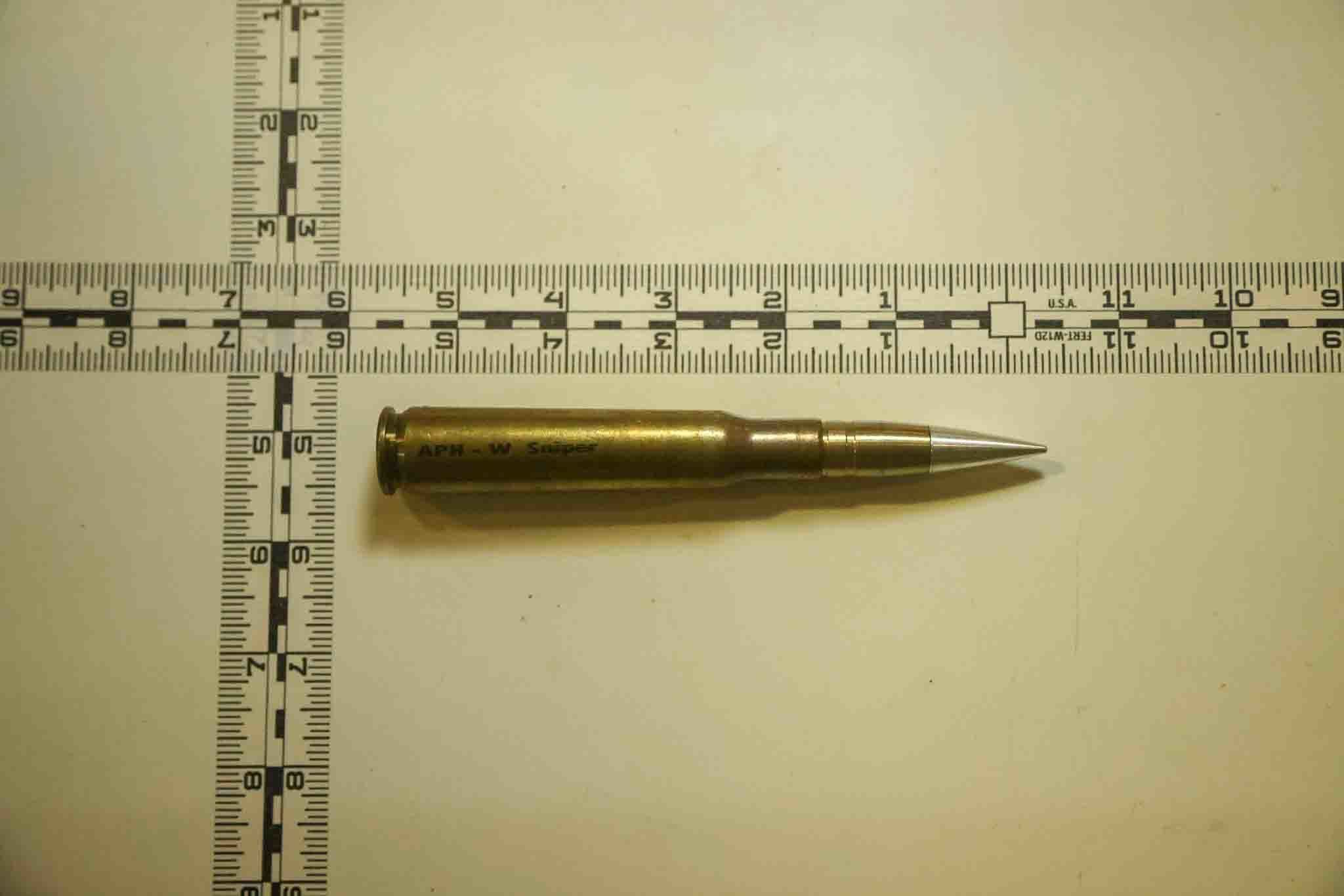In what a U.S. defense official tells us is the first transfer of its kind, 1.1 million rounds of 7.62x54mm ammunition and more than 20,000 rounds of 12.7mmx99mm ammunition of Iranian origin seized last year in the Gulf of Oman has been delivered to Ukraine.
The ammunition was taken from what U.S. Central Command said was a stateless dhow named Marwan 1 on Dec. 9, 2022.
The munitions “were being delivered from Iran’s Islamic Revolutionary Guards Corp to Houthi rebels in Yemen “in violation of the United Nations Security Council Resolution 2216,” according to CENTCOM.
The interception of the Marwan 1 was carried out by the Expeditionary Mobile Base USNS Lewis B. “Chesty” Puller according to court records. You can read more about that ship in our full profile here.
A security team from the ship “boarded the Marwan 1, which was manned by 11 Somali nationals, one Kenyan national, and one Pakistani national. Items discovered by the security team, which were laden on board the Marwan 1, consisted of a cargo of munitions made for conventional weapons,” the records state.
In addition to the ammunition, the security team also seized 6,960 proximity fuses for rocket-propelled grenades and 2,000 kg of propellant for rocket-propelled grenades. It is unclear what happened to the fuses or propellant.

The transfer of the ammunition to Ukraine was made by the U.S. government, which obtained ownership on July 20 through the Justice Department’s civil forfeiture claims against the IRGC, according to a CENTCOM news release issued Wednesday.

It is unknown at this time whether there will be more such transfers to Ukraine.
The U.S. military, together with various allies and partners, regularly conducts counter-smuggling operations to interdict the flow of weapons and other materiel from Iran to Yemen as part of a broader Combined Maritime Forces (CMF) construct.
In addition to the ammunition, there were more than 5,000 assault rifles and a small number of antitank missiles also confiscated around that time “from smugglers suspected of working for Iran,” a Wall Street Journal story from February reported.

While we don’t know at the moment whether rifles will be transferred, given the ongoing war, the addition of another million rounds to feed its small arms that use Russian-designed cartridges is no doubt welcome news in Ukraine. With the amount of support Iran has given to Russia, especially attack drones, there is a fair bit of irony to this move.
Before we head into the latest from Ukraine, The War Zone readers can catch up on our previous rolling coverage here.
The Latest
On the battlefield, it appears that Russia is continuing its efforts to regain territory it has lost during the ongoing counteroffensive.
The Ukrainian Defense Ministry (MoD) on Wednesday said it repelled Russian attacks near Robotyne and Verbove, a salient in Zaporizhzhia Oblast where Ukraine has made the most progress. The Ukrainian MoD said its forces also repelled attacks near Kupiansk in Kharkiv Oblast and Bakhmut in Donetsk Oblast.
The Russian Defense Ministry (MoD) said it inflicted heavy damage to Ukrainian forces near Verbove and Mala Tokmachka and near Kupiansk.
Here are some key takeaways from the latest Institute for the Study of War assessment:
- A Reuters report published on October 3 stated that Russian forces have embedded “Storm-Z” units within conventional Russian units to conduct costly counterattacks against Ukrainian gains in key sectors of the front.
- Ukrainian forces continued offensive operations near Bakhmut and in western Zaporizhia Oblast on October 3.
- Russian forces conducted offensive operations along the Kupiansk-Svatove-Kreminna line, near Bakhmut, along the Avdiivka-Donetsk City line, in the Donetsk-Zaporizhia Oblast border area, and in western Zaporizhia Oblast and reportedly advanced in some areas.
Ukrainian Leopard 2 tank crews told CNN that the longer they work with the Western-donated armor, the better able they are to take advantage what they bring to the battlefield.
In what could be a further blow to its hold on the Crimean peninsula it occupies, Russia has withdrawn some of the vessels that are part of its Black Sea Fleet from its main base at Sevastopol after a series of attacks there, The Wall Street Journal reported Wednesday.
Russia has moved three attack submarines and two frigates from Sevastopol to its Black Sea port in Novorossiysk Russia, according to Western officials and satellite images verified by naval experts, the publication said. The Russian Defense Ministry didn’t respond to a request for comment.
The withdrawal of some of Russia’s warships from Sevastopol follows a series of strikes by Ukraine in recent weeks that have severely damaged Russian vessels and the fleet’s headquarters.
One on Sept. 12 struck two Russian Navy vessels, the Kilo class diesel-electric attack submarine Rostov-on-Don (B-237) and the Ropucha class landing ship Minsk. Images later emerged showing the extent of the damage to the submarine.
A second attack took place Sept. 22 on the headquarters of the Black Sea Fleet. Dozens of Russian naval officers were said to have been killed by that strike. You can see a Storm Shadow cruise missile hitting the building in the video below.
The immediate military effects of the move are limited the Journal noted. The ships will still be able to fire cruise missiles on civilian infrastructure like ports and power grids, naval experts told the Journal.
Besides, there are still many ships left at Sevastopol, a Ukrainian naval expert told us.
“They still have frigates, corvettes, minesweepers, landing ships and others,” said Andrii Ryzhenko, a retired Ukrainian Navy captain. “It doesn’t mean that Russia has left Sevastopol.”

The War Zone cannot rule out this being part of a temporary change in operations rather then a monumental, long term egress of Black Sea Fleet capabilities from Sevastopol. Recent satellite imagery shows the port still packed with naval vessels and Novorosiysk is an established Black Sea Fleet port.
The Ukrainian Defense Intelligence Directorate on Wednesday claimed it carried out another raid on Crimea, the second since Aug. 24. You can read more about that in our story here.
The Security Service of Ukraine (SSU) said its drones destroyed an S-400 Triumf air defense system in Russia’s Belgorod Oblast Wednesday, according to Ukrainian Pravda.
Several explosions can be heard in video posted on social media claiming to show that attack as it occurred. However, the governor of the oblast claims there was no damage inflicted. We cannot independently verify either claim.
“Our air defense system is operating over Belgorod and the Belgorod region – air targets have been shot down,” Vyacheslav Gladkov said Wednesday on his Telegram channel. “Operational services are clarifying information about the consequences on the ground. According to preliminary data, there were no casualties or damage.”
This is the third time since Aug. 24 that Ukraine has claimed to have destroyed an S-400 system.
As we have reported previously, the Ukraine Defense Intelligence Directorate (GUR) claims it struck an S-400 system on Cape Tarkhankut in Crimea on Aug. 24. Ukrainian intelligence officials say they also struck one near the town of Yevpatoriya in occupied Crimea on Sept. 14.
In this wild video, you can watch Ukrainian troops defend a trench against the Russians with assault rifles and grenade launchers.
On his Telegram channel, the soldier who posted the video said that the engagement seen in the footage took place near the village of Novoselivske in Luhansk Oblast and lasted about 20 minutes. It was a small snapshot of four days of heavy fighting, he said.

And finally, move over Harry Potter, Ukraine claims it has created an “invisibility cloak” of its own.
Well, not really invisible, the cloak is claimed to defend against Russian soldiers with thermal imaging cameras and drones with thermal imaging cameras by “blocking the radiation of heat,” according to Ukraine’s Minister of Digital Transformation.
“The design is compact and lightweight, up to 2.5 kg,” Mykhailo Fedorov said Wednesday on his Telegram channel. “It has high protection against rain and wet snow. Also, the raincoat does not burn and protects against high temperatures.”
The video below, he said, “shows a finished sample that has successfully been tested in the field.”
We could not independently verify if this actually works however. Still, this kind of thermal concealment is not new.
That’s it for now. We’ll update this story when there is more news to report about Ukraine.
Contact the author: howard@thewarzone.com
